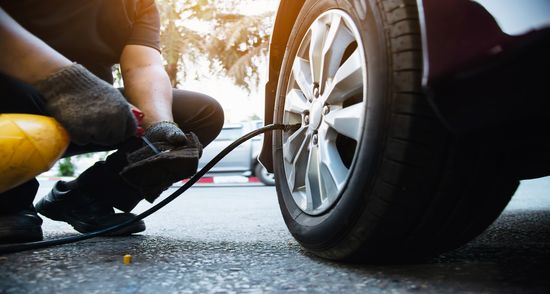As winter comes around the corner, hiking in Oman becomes one of the most sought-after activities.
You pack up all the warmer stuff, safety kits, put on your hiking shoes, and leave for a memorable experience!
As you take the road to your destination, you notice your car is louder than normal and feels like being dragged. You may think you are imagining it but these are the effects of low tire pressure in cold weather.
And this can lead to tire blowout in the worst-case scenario!
So how can you avoid these problems and drive smoothly in the cold weather?
Here is a detailed guide on how cold weather affects your tires and what you should do about it
Why is Tire Pressure Important?
The inappropriate volume of air in your tires can lead to the following consequences:
- Premature & Uneven Wear
- Poor Braking Distances
- Less Responsive Steering and Handling
- Tire Blow Out
- Puncture
- Poor Fuel Economy
But the good news is that these consequences can easily be avoided!
Before we delve into the to-dos, let us discuss how cold weather affects tire pressure.
How Does Cold Weather Affect Tire Pressure?
Since air is made of molecules (a group of two or more atoms), cold temperatures make molecules stick together and move slowly. This leads to molecules taking less physical space. This way the air becomes condensed and leads to a loss of pressure.
TIRE PRESSURE SYMPTOMS TO LOOK FOR IN WINTER
Here are some of the most common symptoms of low tire pressure in cold weather:
- If you have a car model older than 2008, it should have a tire pressure monitoring system (TPMS) installed. If you see TPMS light on even after driving for some time it means that friction of the road isn’t enough to heat the air inside the tire. If the light stays on, you’ll have to check your tire pressure.
- Take a close look at your tires. Do they look flattened? If your tires look deflated in cold weather, there is a high chance that they are. Go for a tire pressure check to avoid any bigger problems such as tire puncture
- Lastly, if you notice louder road noise and the feeling of your car being dragged while driving, it means your tire pressure is low.
How to Check Tire Pressure in Cold Weather
Always make sure to check the tire pressure in Winter when your car has been parked for at least 3 hours as driving raises the air pressure and you will get an incorrect reading.
Then simply follow the steps listed below:
1: Identify the Ideal Tire Pressure
Every tire has its ideal or recommended pressure that is tested for safety concerns by the manufacturer. You should always fill your tire to the recommended safe pressure level to avoid any complications.
You can easily find the tire’s recommended pressure printed on the outside of the tire. It will be listed in PSI (pounds per square inch) around 30-60 PSI.
Once you have checked the ideal pressure of the tire, look for a sticker inside the driver’s door or your owner’s manual to determine the correct PSI given vehicle load and outside temperature.
2: Check the Current Tire Pressure
The next step is to check your tire’s current pressure to determine the amount of air you need to release or add. As mentioned above, let the tires cool down after driving to get an accurate reading.
You’ll need a tire gauge to check the tire pressure. Unscrew the cap of the tire valve & push the tire gauge’s nozzle into the tire valve. Hold the gauge evenly until the sound of the air coming out stops. If you are using a gauge with a digital screen, it will show the PSI & if you are using the analog gauge, you will have to read the pressure indicated by the markings on the stick.
3: Add or Release Air
Once you have checked the recommended and current tire pressure, all you have to do is just adjust the pressure by either releasing or adding air.
If you need any sort of assistance with it, don’t hesitate to visit our store, have Qahwa with us, and let us take care of the rest
Conclusion:
Keeping a regular check on tire pressure in cold weather is important for avoiding any unforeseen problems on the road as well as maintaining the health of your tires.
If you want to keep reading such informative blog posts on tire care, just share your email address, and we will deliver the information to your inbox!



